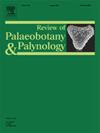Franscinella riograndensis (Salvi et al.) gen. nov. et comb. nov.: The first record of a lycopsid with in situ spores for the Permian strata of the Paraná Basin, Brazil
IF 1.7
3区 地球科学
Q2 PALEONTOLOGY
引用次数: 0
Abstract
The type material of Lycopodites riograndensis was revised alongside the description of new specimens, all originating from an Asselian ash-fall horizon from the Quitéria outcrop in southern Brazil, representing the type locality and stratum of that fossil-species. The adpression fossils were analysed using a set of techniques which revealed new information, including dichotomous isotomous branching, details of the tracheids of the vascular cylinder, and information on sporangial wall cells, in addition to well-preserved in situ isospores. Based on that, Franscinella gen. nov. is proposed to accommodate specimens previously assigned to Lycopodites riograndensis. This represents the first record of in situ spores for late Palaeozoic lycopsids of the Paraná Basin.
riograndfranscinella (Salvi et al.) gen. 11 . et comb.。11月:在巴西帕拉南盆地的二叠纪地层中首次记录到具有原位孢子的石松
在对新标本的描述的同时,对里奥格兰石松的模式材料进行了修订,这些新标本都来自巴西南部quit里亚露头的亚塞利亚火山灰层,代表了该化石物种的模式地点和地层。研究人员利用一系列技术对这些压缩化石进行了分析,这些技术揭示了新的信息,包括二分异质分支、维管柱管胞的细节、孢子囊壁细胞的信息,以及保存完好的原位等孢子。在此基础上,Franscinella gen. nov被认为可以容纳以前归属于Lycopodites riograndensis的标本。这是巴南盆地晚古生代石松类原位孢子的首次记录。
本文章由计算机程序翻译,如有差异,请以英文原文为准。
求助全文
约1分钟内获得全文
求助全文
来源期刊
CiteScore
3.50
自引率
21.10%
发文量
149
审稿时长
6 months
期刊介绍:
The Review of Palaeobotany and Palynology is an international journal for articles in all fields of palaeobotany and palynology dealing with all groups, ranging from marine palynomorphs to higher land plants. Original contributions and comprehensive review papers should appeal to an international audience. Typical topics include but are not restricted to systematics, evolution, palaeobiology, palaeoecology, biostratigraphy, biochronology, palaeoclimatology, paleogeography, taphonomy, palaeoenvironmental reconstructions, vegetation history, and practical applications of palaeobotany and palynology, e.g. in coal and petroleum geology and archaeology. The journal especially encourages the publication of articles in which palaeobotany and palynology are applied for solving fundamental geological and biological problems as well as innovative and interdisciplinary approaches.

 求助内容:
求助内容: 应助结果提醒方式:
应助结果提醒方式:


